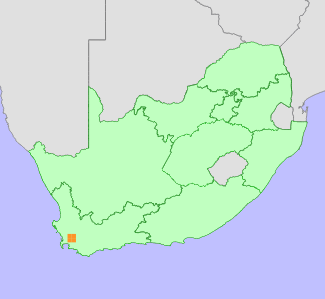|
Scientific Name | Serruria gracilis Salisb. ex Knight |
Higher Classification | Dicotyledons |
Family | PROTEACEAE |
Common Names | Fine Spiderhead (e) |
National Status |
Status and Criteria | Vulnerable A2c; B1ab(i,ii,iii,iv,v)+2ab(i,ii,iii,iv,v) |
Assessment Date | 2020/04/14 |
Assessor(s) | A.G. Rebelo, H. Mtshali, L. von Staden & R. Koopman |
Justification | Serruria gracilis has an extent of occurrence (EOO) of 271-334 km², and an area of occupancy (AOO) of 56-60 km². It has declined significantly across the Cape Winelands and plants at eight known locations continue to decline due to ongoing habitat loss and degradation, and competition from alien invasive plants. A population reduction of 32-40% over the past three generations (150-300 years) is estimated based on habitat loss. It therefore qualifies for listing as Vulnerable under criteria A and B. |
Distribution |
Endemism | South African endemic |
Provincial distribution | Western Cape |
Range | This species has a limited distribution range in the Cape Winelands District, between Du Toit's Kloof, Stellenbosch and Franschhoek. It is endemic to the Western Cape Province, South Africa. |
Habitat and Ecology |
Major system | Terrestrial |
Major habitats | Boland Granite Fynbos |
Description | It occurs on sands and granite slopes, at an altitude of 200-800 m. It is a long-lived species, and survives fires by resprouting from an underground rootstock (generation length 50-100 years). Seeds are released after ripening, and dispersed by ants to their underground nests, where they are protected from predation and fire. It is pollinated by insects. |
Threats |
| Serruria gracilis is threatened by ongoing habitat loss to agricultural expansion (mainly vineyards) and development. It has lost 40% of its habitat to timber plantations in the past. Plantations are no longer expanding, but are a source of escaping seedlings that are invading this species' habitat, and becoming so dense in places to the degree that plants of this species are likely to be outcompeted. |
Population |
The two largest remaining subpopulations of this localized species are on the Du Toit's Kloof Pass and neighbouring areas of the Hawequas Mountains, numbering several hundred plants over a 8 km area. This species also occurs on the summit of Franschhoek Pass, where about 20 plants were counted between 1994 and 2000. A further 20 plants were counted in 1996 on an isolated fragment on the Dassenberg Hill, near Franschhoek. Six plants were found in the Klein Drakenstein Mountains between Paarl and Franschhoek in 1998, and five plants were recorded in 2011 in a lowland fragment in the Groot Drakenstein area that is earmarked for development. This species was historically recorded further north below the Limietberg, but has not been re-located there since the 1960s, and in the Dwarsrivier Valley between Groot Drakenstein and Stellenbosch, where it was last recorded in the 1940s. This species has already lost 40% of its habitat and as a long lived resprouting species this loss translates to a loss of 32-40% of the population in the past three generations (150-300 years). Loss is continuing, causing ongoing population decline.
|
Population trend | Decreasing |
Notes |
| Serruria gracilis and Serruria pinnata were temporarily considered conspecific in the 1990s, but are definitely separate taxa. Whereas S. gracilis is more gracile (slender) and forms dense mats, S. pinnata is more robust and occurs as trailing stems. |
Assessment History |
Taxon assessed |
Status and Criteria |
Citation/Red List version | | Serruria gracilis Salisb. ex Knight | VU B1ab(i,ii,iii,iv,v)+2ab(i,ii,iii,iv,v) | 2015.1 | |
Bibliography |
Manning, J.C. and Goldblatt, P. 2012. Plants of the Greater Cape Floristic Region 1: The Core Cape Flora. Strelitzia 29. South African National Biodiversity Institute, Pretoria.
Rebelo, T. 2001. Sasol Proteas: A field guide to the proteas of southern Africa. (2nd ed.). Fernwood Press, Vlaeberg, Cape Town.
|
Citation |
| Rebelo, A.G., Mtshali, H., von Staden, L. & Koopman, R. 2020. Serruria gracilis Salisb. ex Knight. National Assessment: Red List of South African Plants version . Accessed on 2025/05/31 |
 Comment on this assessment
Comment on this assessment

